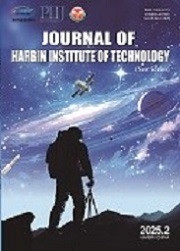| Related citation: | Yanzhang Wang,Yunxia Wan,Chen Chen,Hongyu Shi,Jun Lin,Defu Cheng.Research Status and Key Technologies of Geo-Electromagnetic Magnetic Induction Sensor[J].Journal of Harbin Institute Of Technology(New Series),2017,24(4):38-49.DOI:10.11916/j.issn.1005-9113.15314. |
|
| Author Name | Affiliation | | Yanzhang Wang | Key Laboratory of Geo-Exploration Instrumentation, Ministry of Education, Jilin University, Changchun 130026,China
College of Instrumentation & Electrical Engineering, Jilin University, Changchun 130026, China | | Yunxia Wan | Key Laboratory of Geo-Exploration Instrumentation, Ministry of Education, Jilin University, Changchun 130026,China
College of Instrumentation & Electrical Engineering, Jilin University, Changchun 130026, China | | Chen Chen | Key Laboratory of Geo-Exploration Instrumentation, Ministry of Education, Jilin University, Changchun 130026,China
College of Instrumentation & Electrical Engineering, Jilin University, Changchun 130026, China | | Hongyu Shi | Key Laboratory of Geo-Exploration Instrumentation, Ministry of Education, Jilin University, Changchun 130026,China
College of Instrumentation & Electrical Engineering, Jilin University, Changchun 130026, China | | Jun Lin | Key Laboratory of Geo-Exploration Instrumentation, Ministry of Education, Jilin University, Changchun 130026,China
College of Instrumentation & Electrical Engineering, Jilin University, Changchun 130026, China | | Defu Cheng | Key Laboratory of Geo-Exploration Instrumentation, Ministry of Education, Jilin University, Changchun 130026,China
College of Instrumentation & Electrical Engineering, Jilin University, Changchun 130026, China |
|
| Abstract: |
| According to different applications, the performance parameters of the several Geo-Electromagnetic Magnetic Induction Sensors(GEMISs) which are the most representative in the world are compared. After discussing the several key technologies for improving the performance of GEMISs, the main conclusions are as follows: the application bandwidth can be expanded by adopting flux negative feedback (1 mHz-10 kHz); “laminated” core structure is useful for suppressing eddy current loss; the effective permeability of the core has increased observably after adding flux concentrators to the two ends of the core; the chopper amplifier is a useful method to suppress 1/f noise for reducing the GEMIS’s output noise; the indoor calibration scheme based on “long straight solenoid” proposed to obtain sensor sensitivity. Accordingly, the problem how to reduce the noise of GEMIS is urgent need to be solved, which will improve the performance of GEMIS. And there is plenty of work requires further study on parameters’ optimization of coil and core. In the future, miniaturization, intelligence and three-axis measurement are the development directions of GEMIS. |
| Key words: GEMIS key technologies flux negative feedback “Laminated” core structure flux concentrators |
| DOI:10.11916/j.issn.1005-9113.15314 |
| Clc Number:P319.3+1 |
| Fund: |
|
| Descriptions in Chinese: |
| 地球电磁探测用磁感应传感器研究现状及关键技术 王言章1,2,万云霞1,2,陈晨1,2,时洪宇1,2,林君1,2,程德福1,2 (1. 吉林大学 地球探测仪器教育部重点实验室,长春 130026; 2.吉林大学 仪器科学与电气工程学院,长春 130026) 创新点说明:根据其应用背景,对比了当今世界最具有代表性的几种地球电磁探测用感应式磁传感器(GEMISs)的性能参数。讨论了几种提高GEMISs的关键技术,得出如下结论:采用磁通负反馈技术可以扩展应用频带(1mHz-10kHz);“叠片式”磁芯结构可有效抑制涡流损耗;在磁芯两端增加磁通集中器的方式可以有效提高传感器的有效磁导率;采用斩波放大电路的方式可以有效降低传感器输出端的1/f噪声;在屏蔽室内采用“长直螺线管”的方法获得了传感器的灵敏度曲线。然而,如何进一步降低传感器的噪声水平将是未来研究的重点问题,该问题的解决对于提高传感器性能具有重要作用。另外,在传感器线圈和磁芯性能参数优化问题上还有很多研究工作需要做。在未来的研究工作中,小型化、智能化和三轴测量将是地球探测用传感器的主要研究方向。 研究目的: 系统详细介绍作者所在单位在研制地球电磁探测用感应式磁传感器过程中所采用的关键技术及取得的一些有突破性的技术指标,并与国外的一些典型同类产品进行了对比,确定该产品在国际中的地位和水平。通过一些参数对比和应用实例,说明本单位研制的此类传感器可满足地球电磁探测的要求。 研究方法: 在研究过程中,主要采用仿真与实验结果相结合的方式对提出的技术进行验证与修改;实验数据的获得主要是借助于加拿大凤凰公司的V8电磁系统进行数据收集;灵敏度测试主要利用实验室的电磁屏蔽室和电磁屏蔽筒。 结果: 根据实验结果分析,磁通负反馈技术可使得整个应用频段内的相位变化平滑,有利于地球电磁探测的应用;n片磁性材料合成的“叠片式”磁芯结构的涡流损耗要比实心磁芯降低n倍;在磁芯两端增加磁通集中器,可以使磁芯的有效磁导率显著提高;斩波放大电路可有效降低1/f噪声,提高系统分辨率;基于螺线管的在线标定技术可获得传感器的灵敏度曲线。 结论: 本文通过对传感器设计过程中的几项关键技术研究,将其应用到传感器设计中,并进行了实验验证,使得研制的传感器指标有了较显著的提高。通过在不同地区的实验验证,并与国外同类仪器的产品结果进行了对比,在灵敏度、频带宽度等方面均可满足地球电磁探测的要求。应用实例表明,本文所研制的传感器在性能指标上已经达到国际先进水平。 关键词:地球电磁探测用感应式传感器,关键技术,磁通负反馈,“叠片式”磁芯结构,磁通集中器 |




